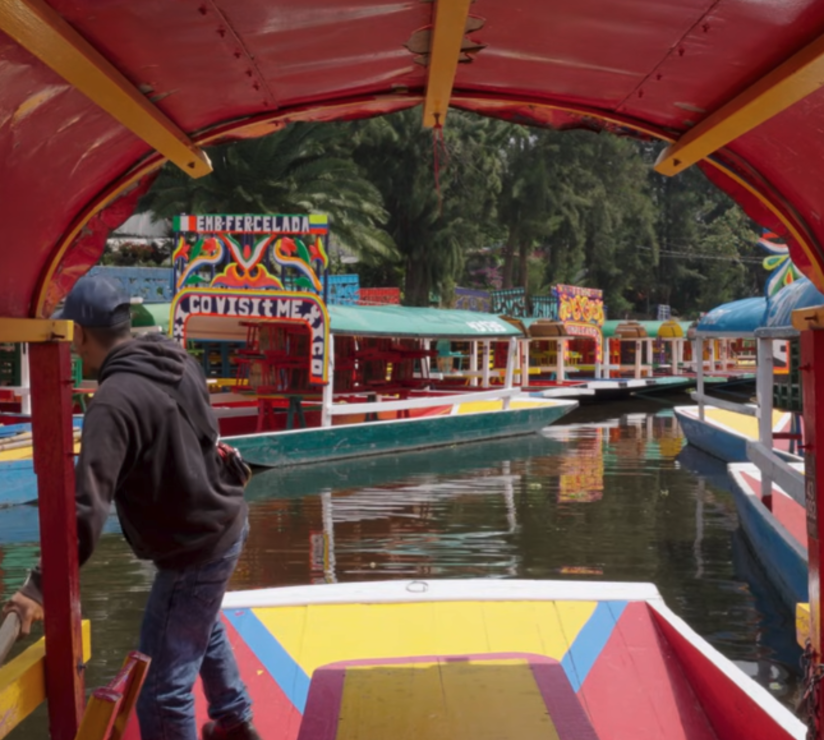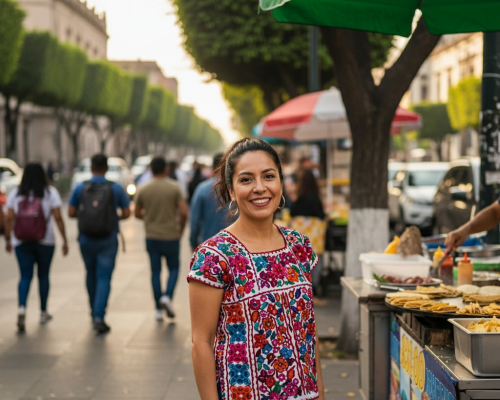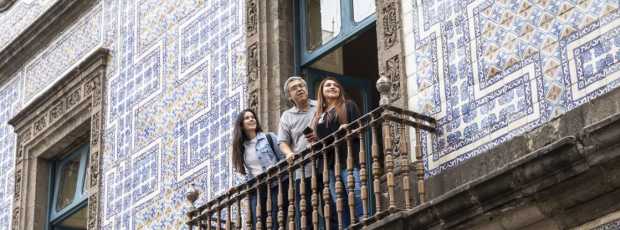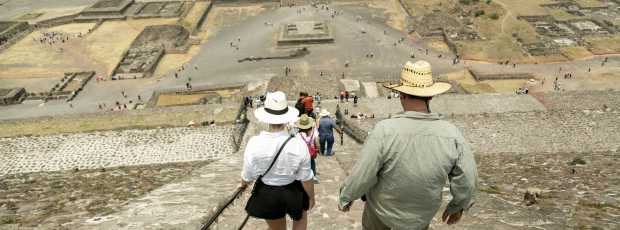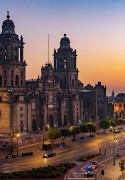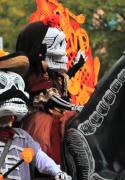An absolute must in Mexico City. Marisol's passion for the city is contagious. We learnt so much about Mexico City and the culture. We also had the most amazing food and company. Mexico and Marisol have a special place in our hearts.Kathryn, Mexico City, 2025
See Mexico City’s Hidden Side on a Private Tour
Private tours, designed around you
Table Of Contents
- The Rituals That Define January Here
- Must-See Places That Earn Their Reputation
- What to Skip, Tweak, or Swap
- Food That Defines January in Mexico City
- Cultural Events and Performances
- Neighborhoods That Reveal the City
- Tailoring Your Visit to What You Love
- January Festivals and Family Traditions
- Practical Tips: What You Need to Know Before You Go
- Frequently Asked Questions About Visiting Mexico City in January
- What January Teaches You About This City
January in Mexico City feels different. My abuela and I are sitting on her porch in Coyoacán at 7 in the morning, hands wrapped around cups of café de olla, watching our breath fog in the cold weather. By noon, we'll have shed our sweaters and the Zócalo will be flooded with that sharp, clear light that only happens in the dry season. This is my favorite version of the city, and the best time to tap into Mexico City experiences with a local lens.
I've spent 34 Januaries here, and this month has a specific rhythm you won't find in guidebooks. December exhausts everyone with posadas and family obligations. By January, we settle back into ourselves. The tourists who mobbed the Zócalo for New Year's have mostly left. The locals reclaim the streets. This is the best time to visit Mexico City for anyone wanting to explore Mexico City beyond the tourist crowds.
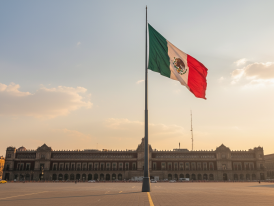
Sunrise over a quiet Zócalo in January light
This isn't a month for rushing through attractions with a checklist. January asks you to slow down, to notice the tamale vendor who sets up at the same street corner every morning at 6:30 AM, to spend three hours at lunch because the conversation matters more than the schedule. If you want to understand why eight million of us choose to stay in this chaotic, beautiful, overwhelming city, keep reading.
The Rituals That Define January Here
January 6th is circled on every calendar in my house. Día de los Reyes Magos means Kings Day, and it means my abuela starts baking at 5 AM. The smell of rosca de reyes pulls the whole neighborhood out of bed.
Rosca de Reyes on King's Day Morning: Sweet Bread and Hidden Surprises
The rosca tradition works like this: we gather around the table, slice the oval bread studded with candied fruit, and hope we don't find the tiny baby Jesus figurine baked inside. Find it, and you're hosting tamales on February 2nd. My cousin Marco found three last year and complained for weeks, then threw the best tamaliza the family had seen in years.

Rosca and warm atole on a wooden table
Panadería Rosetta makes the version I bring when I want to impress my aunts. Flaky pastry instead of dense sweet bread, filled with orange blossom cream, dusted with almond praline. They often sell out early on King's Day. Book ahead. The drink that matters is atole, that thick, warm corn beverage flavored with cinnamon or chocolate. The vendor outside the Coyoacán market every Sunday makes hers with piloncillo and Mexican cinnamon. I've bought from her for twelve years. Unlike pan de muerto, which defines October's Day of the Dead celebrations, rosca de reyes belongs entirely to January.
Chapultepec Mornings: Clear Light, Long Walks, No Rush
Chapultepec Park covers about 1,600 acres, one of the largest urban parks in the world. January mornings here feel different. The air is crisp, the light cuts through the ahuehuete trees just right, and you can hear birds instead of just traffic. This is the time to visit Mexico City's green heart.

Clear morning light through ahuehuetes in Chapultepec
On Sundays, Reforma Avenue closes to cars from 8 AM to 2 PM, turning into a bike lane that stretches from Polanco to the historic center. Families bike, jog, and roller-skate the route. Start at Chapultepec, walk toward the lake, and maybe rent a rowboat. The real pleasure is wandering between the National Museum of Anthropology and smaller museums, finding spots where locals spread blankets for picnics.
Sunday Tianguis: Where Neighborhoods Actually Shop
Every neighborhood has its tianguis, those sprawling open-air markets that pop up weekly. Sunday is when they all happen at once. If you want to understand how this city functions, forget museums. Go to a tianguis.

Vendor stacking chiles at Coyoacán tianguis
In Coyoacán, the market spreads across several blocks near the main square. Fresh nopales, herbs bundled with string, secondhand books, embroidered tablecloths, vendors who remember your face. I shop here every Sunday with my abuela's list. La Merced market operates daily and offers the full-intensity version. Massive, chaotic, raw. Go in the morning when the energy peaks and the produce is freshest.
What If Your Next City Day Didn’t Come From a Guidebook?
Instead of following a script, we connect you with someone who lives there and knows the places worth your time.
Must-See Places That Earn Their Reputation
Some spots deserve your time because they're incredible, not because every tourist list repeats them. These are places I'd take friends from out of town, the ones that live up to their hype. As a local guide who's spent three decades watching visitors navigate this city, I know which spots deliver.
Metropolitan Cathedral and the Zócalo: Colonial Power in Stone at Dawn
The Metropolitan Cathedral took 250 years to build, and you can see it in the architecture. Baroque, neoclassical, and churrigueresque styles layered on top of each other, the whole thing slowly sinking into the soft lakebed we built this city on. The cathedral anchors the UNESCO World Heritage Site that is Mexico City’s Historic Center, and the history runs deep.
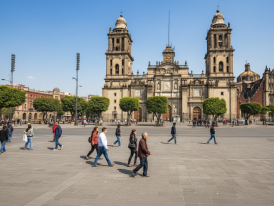
Cathedral facade glowing at dawn from the Zócalo
January mornings here are the secret. Arrive at dawn when the low temperature hovers around 45°F (7°C), when you can hear the bells without competing with vendors setting up. Walk the entire perimeter and notice how the building tilts slightly. The main square changes personality throughout January. Early in the month, holiday decorations might still linger. By mid-month, it returns to its regular rhythm of protests, celebrations, and daily chaos.
Palacio de Bellas Artes: Murals That Demand Your Attention
Palacio de Bellas Artes sits ten minutes from the Zócalo, Art Nouveau and Neoclassical outside and Art Deco inside, its dome a mosaic of orange and yellow tiles framed by copper ribs. But the building is just the container. The treasure lives on the walls.

Upward view of Rivera mural inside Bellas Artes
Diego Rivera's "Man, Controller of the Universe" (his re-creation of "Man at the Crossroads") covers an entire wall. José Clemente Orozco, David Alfaro Siqueiros, and Rufino Tamayo all left incredible murals here, too. The colors stay intense after decades, and standing in front of Rivera's work hits differently than seeing it in photographs. January means manageable crowds, which means you can spend time with each mural instead of shuffling past. The palace also hosts Ballet Folklórico de México on select days throughout the week. Performance days vary, so book ahead.
Templo Mayor: Two Cities, One Footprint
Right beside the Metropolitan Cathedral stand the ruins of Templo Mayor, the main temple of Tenochtitlan, the Aztec capital. This archaeological site was discovered in 1978 when electrical workers stumbled on a massive stone disk of the moon goddess Coyolxauhqui.

Templo Mayor stones with cathedral tower behind
The Templo Mayor Museum walks you through excavation layers, showing artifacts like jade masks and obsidian knives. The museum closes on Mondays. January's clear skies make the outdoor ruins photogenic, and cooler temperatures mean you can linger without wilting. What gets me every time is this: you're standing in modern Mexico City, surrounded by colonial architecture, but underneath everything is Tenochtitlan. The Aztec capital rivaled Venice in size. Two cities occupying the same space, separated by centuries. This archaeological site forces you to reckon with that layered history.
Frida’s Blue House in Coyoacán: Personal History Preserved
The Frida Kahlo Museum sits in my neighborhood. Frida was born in this blue house, lived here with Diego Rivera, and died here in 1954. The museum preserves her studio, bedroom, kitchen, and garden exactly as she left them.

Cobalt blue wall and cactus in Casa Azul courtyard
January is the time to visit Mexico City museums because summer crowds haven't arrived. Book tickets online at least a week ahead. Aim for a 10 or 11 AM slot when natural light floods the courtyard. After the museum, walk to Coyoacán’s main square. Street performers, cafes with outdoor seating, weekend artisan markets. Locals meet friends here, eat churros, and watch the world pass.
The Anthropology Museum: Pre-Hispanic Treasures Under One Roof
This museum houses one of the world's largest collections of ancient Mexican art. Located inside Chapultepec Park, it covers pre-Hispanic civilizations: Maya, Aztec, Olmec, and dozens of others you've never heard of. The impressive collection spans centuries of cultural heritage from central Mexico.
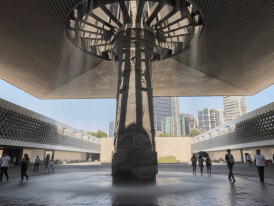
El Paraguas fountain misting in museum courtyard
You could spend a full day here. If you can't, focus on the Mexica (Aztec) hall and the Maya hall. The Aztec Sun Stone dominates the main area and justifies admission alone. The Mayan jade masks, detailed sculptures, and recreated tombs show sophistication that challenges assumptions. January weather makes this visit comfortable because you're moving between climate-controlled galleries and outdoor courtyards. The museum's courtyard features a massive umbrella fountain that's become an architectural icon.
Beyond the Checklist
Discover the city guidebooks don’t cover with a local by your side.
What to Skip, Tweak, or Swap
Not every famous spot deserves your limited time. Here's what I'd adjust after watching tourists navigate this city for three decades. If you collect hidden gems in Mexico City, San Ángel on a Saturday belongs on your list.
Worth Keeping: Early-Morning Historic Center Before the Crowds
The historic center is overwhelmed by mid-morning when vendors set up, tours converge, and energy shifts from peaceful to chaotic. But arrive around 7 or 8 AM, and something magical happens. The main attractions stay mostly closed at this hour, but the streets themselves become the point. Watch the city wake up. Smell vendors preparing breakfast. See the Zócalo empty and vast before it fills with people.
I walk from the Zócalo down Madero Street toward Bellas Artes at dawn, maybe twice a month. Colonial architecture looks softer in early light. By 10 AM, leave for other neighborhoods before tourist traffic peaks.
Better Timing: Weekday Mornings at Casa Azul
Everyone wants to see Casa Azul, which is fine, but weekends turn into human gridlock. Visit on a weekday morning in January, and the experience improves dramatically. The museum closes on Mondays, so Tuesday through Thursday mornings are optimal. Don't try to see both Casa Azul and the Diego Rivera Studio Museum in San Ángel on the same day. They're far apart, and rushing between them means appreciating neither.
Smarter Alternative: San Ángel Over Weekend Coyoacán Chaos
While everyone crowds into Coyoacán, San Ángel offers quieter colonial charm with its Saturday art market, Bazar Sábado. The neighborhood centers on a plaza surrounded by restaurants and art galleries, with some of the best-preserved colonial architecture in the city.

Textiles and pottery at Bazar Sábado stalls
The Diego Rivera and Frida Kahlo Studio Museum is here, designed by Juan O'Gorman in a functionalist style. Two separate buildings connected by a bridge, one for Diego, one for Frida, during their second marriage. The light is phenomenal. San Ángel gets less tourist traffic than major neighborhoods, giving you breathing room. The Saturday market features genuine artisan work instead of mass-produced souvenirs.
It’s about warming your hands around a cup of atole at 7 AM, eating rosca with your entire extended family, and finding the pozole stand that's been simmering broth since dawn.
Food That Defines January in Mexico City
January food here isn't about fancy restaurants or Instagram moments. It's about warming your hands around a cup of atole at 7 AM, eating rosca with your entire extended family, and finding the pozole stand that's been simmering broth since dawn. These are the flavors that define the month.
Where to Find the Best Rosca de Reyes: Atole, Figurines, and Candelaria
Everyone makes rosca for King's Day, but Rosetta's version is the one I bring to my abuela's house when I want to impress the aunts. Flaky, buttery pastry instead of dense sweet bread, filled with orange blossom cream, dusted with almond praline. They often sell out early on January 6th.
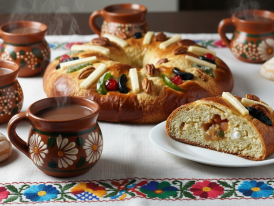
Rosca with hidden baby Jesus figurine and atole cup
The tradition of hiding figurines matters here. Finding one means you're hosting tamales on Día de la Candelaria (February 2nd), which sounds like a burden but means you get to throw a party. Atole is what makes the rosca complete. That warm, thick corn drink flavored with cinnamon or chocolate. Vendors sell it from giant pots at markets, and honestly, theirs tastes better than café versions.
Suadero at 10 PM: The Tacos I Dream About
Los Cocuyos in the Centro is where I go when I need tacos de suadero that remind me why I’ll never leave this city. The beef simmers in its own fat until the edges crisp while the center stays tender, then it lands on small corn tortillas, always doubled, with their green salsa.
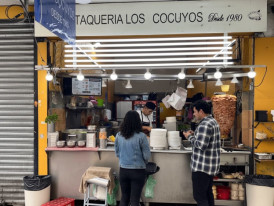
Taqueria Los Cocuyos
If I’m out on a Tuesday around 10 PM, I’ll swing by and start with three. You’ll want six. For breakfast tacos, the stand outside Mercado Medellín does something with scrambled eggs, black beans, and fresh cheese that shouldn’t work but does.
Pozole That Fixes Everything: The Bowl That Warms January
When the temperature drops, which in January means mornings hovering around 45°F (7°C), I crave pozole. Casa de Toño has multiple locations and serves solid pozole, but I prefer the version at Mi Fonda on Calle Puebla in Roma.

Steaming pozole with radish and cabbage on top
The owner, Señora Martha, makes red pozole the way her grandmother taught her. She uses pork shoulder and pig's feet for the broth, simmers it for six hours with guajillo and ancho chiles, and adds the hominy at the end. The bowl arrives steaming, and you build it yourself with shredded cabbage, radish slices, dried oregano, lime, and tostadas. Martha's Fonda has six tables, plastic chairs, and a handwritten menu. It's perfect.
Cafes Worth Lingering In
Roma has become the city's coffee epicenter, with specialty roasters and cafes occupying restored mansions and corner storefronts. January afternoons are perfect for claiming a table at places like Café Nin, Blend Station, or Quentin Café, ordering a flat white or café de olla, and watching the tree-lined streets fill with people. The jacaranda trees won't bloom until March or April, but even in January, the neighborhood's architecture and energy make it ideal for extended cafe time.
Don’t Just Visit. Feel Part of It.
Locals share their city as they live it, so even a few hours can feel like you truly belong.
Discover the differenceCultural Events and Performances
January brings specific cultural events and performances you won't find in other months. Here's what deserves a spot in your schedule when you explore events based on local calendars.
Ballet Folklórico: Two Hours Across Regional Mexico
Ballet Folklórico de México performs regularly at Palacio de Bellas Artes, condensing Mexican culture into regional dances, music, and costumes. The show covers different states: Jalisco's hat dance, Veracruz's son jarocho, and Oaxaca's guelaguetza. January performances are less mobbed than peak season. Performance days vary, so book online ahead of time. Arrive early to spend time with the building’s Art Deco interior before the lights dim.
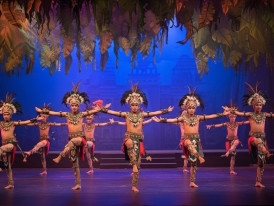
Dancers in traditional costumes on the Bellas Artes stage
Gallery Openings in Juárez: Contemporary Art Off the Tourist Map
Colonia Juárez bridges Roma and the historic center, with an emerging gallery scene. Galleries like Lodos, House of Gaga, and Yautepec show contemporary Mexican and international artists, often with opening receptions that welcome curious visitors. January is when galleries launch new exhibitions after the holiday break. Most are free to enter.
Free Sunday Performances: The City’s Unscripted Stage
Free outdoor entertainment happens constantly, but Sundays concentrate it. In Coyoacán's main square: folk bands, string quartets, magic shows, dance performances. In the Centro, the Zócalo hosts traditional dances, political theatre, and experimental music. The beauty is unpredictability. You might catch abuelas dancing cumbia, a clown act, or a protest march that turns into an impromptu concert.
Ever Wonder What Rome Feels Like Beyond the Sights?
Discover neighborhoods, flavors, and everyday life with a local.
Neighborhoods That Reveal the City
Each neighborhood shows you a different version of what this city can be. I live in one, work in another, and escape to the rest when I need a perspective shift.
Roma Norte: Tree-Lined Streets and Art Deco Charm
Avenida Álvaro Obregón runs through as the main artery, lined with restaurants, bookstores, and design shops. But real character lives on side streets like Orizaba, Córdoba, and Colima, where early 20th-century mansions became boutique hotels, galleries, and cafes.
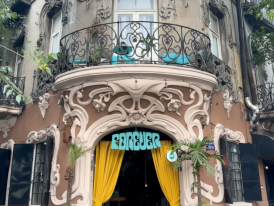
Art Deco doorway on a shaded Roma side street
What defines the neighborhood is its walkability and density of interesting spots within compact blocks. January weather makes it perfect for exploring on foot because temperatures cooperate and outdoor seating stays comfortable most of the day. Walking distance to Condesa makes it easy to combine both. Within a few blocks, you'll find things to do in Mexico City that don't feel staged.
Condesa: Park Life and Art Deco Architecture
Two green spaces anchor Condesa: Parque México and Parque España. They create a village-within-the-city atmosphere. Architecture here is Art Deco and functionalist from the 1920s and 1930s, with curved balconies and geometric details.

Cafe in Colonia Condesa
Parks fill with joggers, yoga classes, and families throughout the day. Streets radiating outward hold restaurants, vintage clothing stores, and neighborhood cantinas. Come here for peaceful mornings rather than intense sightseeing. The vibrant atmosphere never feels overwhelming. Sunday mornings mean breakfast at Lalo or Panadería Rosetta, followed by a walk around Parque México. Jacaranda trees bloom later in spring with their purple blooms transforming entire streets, but the parks are beautiful even in January's clear skies.
Coyoacán: Village Life Beyond Casa Azul
I'm biased about Coyoacán since I live here, but it offers something distinct. The area predates Spanish arrival, serving as a separate settlement before absorption into greater Mexico City. That history shows in the layout, which follows a colonial grid around two main plazas.
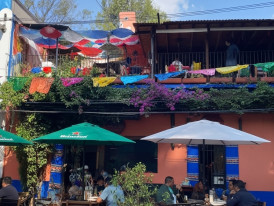
Colonial architecture in Coyoacán
Beyond Frida's museum, Coyoacán rewards wandering. Check out Fonoteca Nacional for free concerts. Browse bookshops around the main square. Grab a torta at El Parnita. Weekend markets spread through streets, selling crafts, used books, and local specialties. The neighborhood maintains a strong local identity despite visitor traffic. Elderly couples on park benches, students from nearby universities, and families who've lived here for generations keep Coyoacán grounded.
San Ángel: Colonial Quiet and Cobblestone Streets
Two plazas anchor San Ángel: Plaza San Jacinto and Plaza del Carmen, surrounded by colonial buildings that now house restaurants, cultural centers, and galleries. The neighborhood maintains a separate-village feeling.
Saturday art market is the main draw, but San Ángel rewards weekday visits too. Casa del Risco museum features a colonial mansion with a fountain made entirely from antique plates. San Ángel Inn offers upscale Mexican dining in a hacienda setting. Colonial architecture here is some of the best-preserved in the city. Less commercial density than other neighborhoods. It's farther from metro stations, so plan on a taxi or rideshare.
The Historic Center: Centuries Layered on Centuries
Beyond obvious spots like the Zócalo, Metropolitan Cathedral, and Palacio de Bellas Artes, the Centro holds layers demanding slow discovery. Walk down Calle Madero, but duck into side alleys where bookstores, taco stands, and courtyards hide. Visit Palacio de Iturbide for its baroque architecture, or Palacio Postal for its golden Art Nouveau interior. These buildings are free to enter and showcase the wealth that once flowed through this area.
The Centro also has some of the city's best cantinas and traditional restaurants, places that have operated for decades, serving the same recipes to the same families. Find quiet corners in hidden courtyards where the noise fades and you can catch your breath between the chaos. History's weight as living continuity, not a museum piece.
Travel Mexico Your Way
Skip the rigid schedules. With City Unscripted, locals shape each day around you, your pace, and what really interests you.Tailoring Your Visit to What You Love
The city works for different interests. Here's how to shape your visit around what matters most to you. This is the best time to visit Mexico City for personalized explorations.
Art and History Trails: A Museum Loop That Actually Flows
If museums and galleries are your focus, start with the Anthropology Museum for the pre-Hispanic context, then visit Templo Mayor to see the archaeological site in its location. Move to Palacio de Bellas Artes for murals and architecture, then explore smaller spots like Franz Mayer Museum or Museum of Popular Art.

Visitor before massive stone carving in museum hall
January's cool weather makes walking between museums comfortable. Many cluster in and around Chapultepec Park, letting you hit several in one day while taking breaks in green spaces.
Markets and Local Food: How Locals Browse and Eat
Markets are where food culture lives most authentically. Start at La Merced for the overwhelming central market experience, then work through smaller neighborhood markets like Medellín Market (international ingredients) or Jamaica Market (wholesale flowers).
Pick a neighborhood, walk its main and side streets, and try whatever looks good. Trust taquerías with long lines, fondas with plastic tables and handwritten menus, juice stands squeezing fresh orange juice. Don't skip tianguis markets on their designated days. Each neighborhood's weekly market offers local specialties, from herbal remedies to handmade tortillas to seasonal fruit. Mexican culture through food, unfiltered.
Getting Outside the City Center: Forests, Canals, and Pyramids
For a great city built on a dried lakebed, outdoor opportunities surprise people. Chapultepec is the obvious start, but Desierto de los Leones National Park sits 45 minutes away and offers forest hiking.
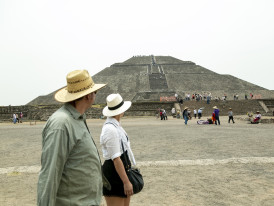
The Sun Pyramid in Teotihuacán
Xochimilco's floating gardens provide a unique and memorable way to spend an afternoon. Rent a trajinera, cruise the canals, snack, and listen to mariachi bands drift past. In January, a trajinera ride is a peaceful and scenic experience that beats the party mood of warmer months. For ambitious day trips, head to Teotihuacán to climb the pyramids. At Teotihuacán, climbing rules change often. Right now, visitors can walk the base areas and climb only the first level of the Pyramid of the Moon, while the Pyramid of the Sun remains closed. January's cooler temperatures make the climb more pleasant, and the site is less crowded. Go early, bring water, and plan for at least four hours.
Wish You Could Just Ask a Local?
Book a quick video call and get insider answers to your trip questions.
January Festivals and Family Traditions
King's Day (January 6) is the month's major festival, but other events appear throughout. Check listings for performances at Palacio de Bellas Artes, free concerts at Fonoteca Nacional, and art openings across galleries.

Monarch butterflies clustered on oyamel branches
The Monarch Butterfly Migration peaks in January at sanctuaries three to four hours outside the city. Day trips to El Rosario or Sierra Chincua let you witness millions of monarch butterflies clustering in oyamel fir trees, an awe-inspiring spectacle that only happens during the winter months. Go mid-week with an early start for the best experience. This is one of the best outdoor activities available. Many churches hold special masses and celebrations throughout January, particularly around Día de los Reyes. Even if you're not religious, the cultural significance makes these events interesting to witness respectfully.
Practical Tips: What You Need to Know Before You Go
I get asked practical questions constantly. Here's what matters based on living here for 34 years.
How January Weather Works Here: Layers, Sun, and Altitude
- Dry season rules: November through April mean almost zero rain, unlike the rainy season from May to October. January sits dead center, giving you clear skies nearly every day.
- Temperature swings: Mornings start around 45°F (7°C), afternoons hit 72°F (22°C). Temperatures ranging from cold to warm throughout the day mean layering is essential. Unlike summer months when the heat stays constant, January gives you variety.
- What I wear: Light jacket in the morning, long-sleeve shirt underneath, then down to just the shirt by lunch when warm days kick in. Repeat daily.
- Altitude matters: We sit at 7,350 feet (2,240 meters) above sea level. The sun hits harder than you expect. Sunscreen and a water bottle are non-negotiable.
- Dry air reality: Humidity drops below 30%. Bring moisturizer and lip balm. I keep hand lotion in my bag all January.
Museum Strategies: Closures, Free Sundays, and Booking
- Monday closures: Almost every major museum closes on Mondays. Non-negotiable.
- Sunday crowds: Free admission for Mexican nationals means more people, but also a more authentic atmosphere.
- Book ahead: Frida Kahlo Museum to skip entry lines. For the Anthropology Museum, arrive early.
- Walk-up works for: Most other museums in January when crowds thin out.
Getting Around Without Drama: Metro, Apps, and Walking
- Metro system: Reliable, cheap, covers most tourist areas. Key stations: Zócalo (Line 2), Bellas Artes (Lines 2 and 8), Insurgentes (Line 1), Chapultepec (Line 1).
- Women-only cars: The first cars are reserved for women and children all day, every day.
- Download the Metro CDMX app: Route planning is easier. Buy a rechargeable card instead of paper tickets.
- Uber and Didi: Use them for evening travel or neighborhoods far from the metro.
- Walking: Roma, Condesa, Coyoacán, and San Ángel are extremely walkable. The historic center requires more patience with crowds.

Metro train
Day Trips Under Two Hours: Quick Escapes That Deliver
- Teotihuacán (1 hour): Bus from Terminal del Norte. The pyramids open at 8 AM. Arrive early. Current rules let you walk the base areas and climb only the first level of the Pyramid of the Moon, while the Pyramid of the Sun is closed to climbing.
- Tepoztlán (90 minutes): Small-town atmosphere, weekend market, mountain temple hike.
- Valle de Bravo (2 hours): Lakeside escape with sailboats, forest walks, and good restaurants.
- Puebla (2 hours): Colonial architecture, Talavera pottery, and mole poblano in its birthplace.
Accessibility Notes: Step-Free Wins and Sidewalk Reality
- Step-free museums: Anthropology Museum, Palacio de Bellas Artes, and Templo Mayor Museum have elevators.
- Sidewalk reality: Historic center has uneven sidewalks often blocked by vendors. Roma and Condesa maintain sidewalks better.
- Solo travelers: Roma, Condesa, Coyoacán, and Polanco feel comfortable walking alone during daylight.
What to Pack: The January Essentials
- Light jacket: Non-negotiable for mornings and evenings.
- Walking shoes: Comfort beats fashion.
- Sun protection: Sunscreen and sunglasses are essential.
- Water bottle: Reusable bottle for constant hydration.
- Skip the umbrella: Deep in the dry season means rain is unlikely.
Frequently Asked Questions About Visiting Mexico City in January
1) Do I need to speak Spanish to get around Mexico City?
Not essential, but basic phrases help a lot. Use Google Translate offline and expect less English in markets and small eateries.
2) Is tap water safe to drink in Mexico City?
No—stick to bottled or purified water (including for brushing teeth). Ice at established venues is typically purified.
3.) How much cash should I carry daily?
About 500–1,000 MXN works for street food, markets, and small vendors. Keep small bills; cards are widely accepted elsewhere.
4) Is street food in Mexico City safe to eat?
Yes, if you follow the lines, busy stalls with high turnover are safest. Start light if you have a sensitive stomach.
5) What should I know about altitude sickness?
CDMX sits at ~2,240 m (7,350 ft). Hydrate, go easy the first day, and limit alcohol; most people acclimate within 24–48 hours.
6) How much should I tip in Mexico City?
Restaurants 10–15% (15% for great service). Small tips for taxis, cafés, and attendants (5–20 MXN) are appreciated.
7) Can I visit the Monarch Butterfly sanctuaries in January?
Yes—January is peak. Plan a midweek early start to El Rosario or Sierra Chincua, dress warm, and expect a 3–4 hour trip.
8) Are Uber and taxis safe to use at night?
Use Uber/Didi or official sitio taxis. Avoid hailing random street cabs after dark and verify plates in the app.
9) Do I need vaccinations or medications for Mexico City?
No special shots are required. Being up to date on routine vaccines is wise; talk to your doctor about Hep A/Typhoid if unsure.
10) Can I use my cell phone in Mexico City?
Most phones work with roaming; costs vary by carrier. An unlocked phone with a local SIM is cheap and reliable, and Wi-Fi is common.
What January Teaches You About This City
I'm writing this from Café Nin, where I've spent every Tuesday afternoon for the past year. It's 3 PM, that quiet hour between lunch and evening when the neighborhood slows down. A couple at the next table is arguing softly about whether to stay another week or head to Oaxaca. The jacaranda tree outside is bare, waiting for spring. The light turns everything gold.
This is what January gives you here. Not the dramatic moments you'll post online, but the in-between spaces where you stop being a tourist and just exist for a minute. The tamale vendor who insists you try something different. The woman at La Merced who teaches you how to make proper tea. The afternoon you skip your travel plans because the light in Coyoacán is too good to waste indoors.

Late afternoon sun across a café table and window
Mexico City in January doesn't ask much. Just attention. The details, the rhythms, the moments between moments. That's where the city lives, and that's what you'll remember when someone asks what you did here. You'll struggle to answer, and that means you did it right.
Explore Mexico City Year-Round
Ready to Plan Your Perfect Day in Mexico City?
Start your experienceWhat If Your Day in Mexico City Was Planned by Someone Who Knows It — and You?
City Unscripted matches you with a local host who creates a private experience based on your interests, not a set route.
Explore With UsWant to Experience the Real Mexico City With Someone Who Lives There?
A fully private experience, planned and led by a local host who tailors the day to you
